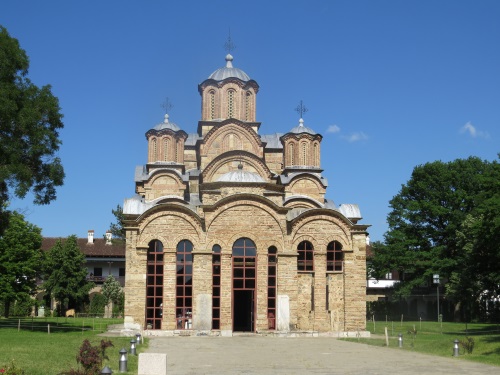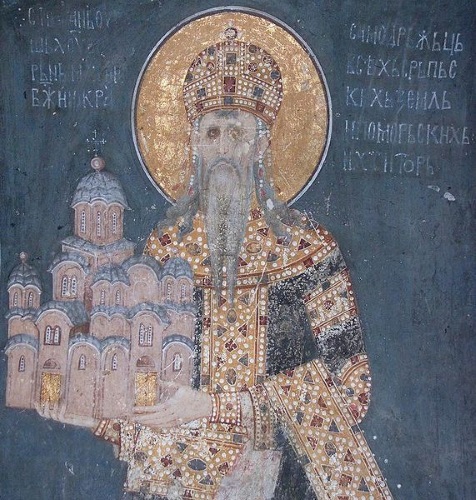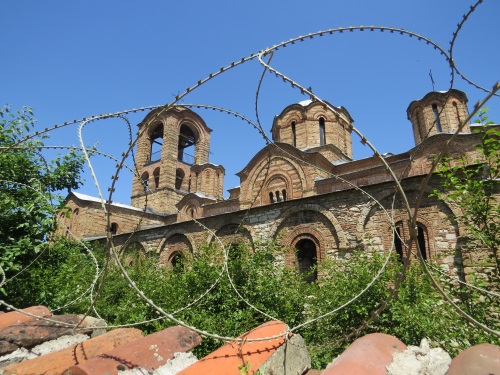Basing myself in Kosovo’s capital Pristina, I visited 2 out of the 4 locations that comprise the
Medieval Monuments in Kosovo: Gracanica Monastery and Prizren's Our Lady of Ljeviš church. They are considered ‘In Danger’ since 2006 as they need “urgent conservation work” and safeguarding, due to the post-conflict situation which saw this Serbian WHS end up on the territory of the partially recognised state of Kosovo.
In the months prior to this trip I had scoured the Internet for information on how to reach the monastery of Gracanica. It lies just 10 kilometers from Pristina, but in a Serb enclave whose surroundings pretend it does not exist. I was almost deterred by the transport issues described in the Lonely Planet chapter on Kosovo (“Rumours abound that bus drivers won’t let you on or off if you tell them where you’re going”) and the stories that run on
Tripadvisor about encountering “unwelcoming nuns” at the monastery itself.
 |
| Church of Gračanica monastery |
In reality it took me a lot of effort and time (2 hours) to get there. But that had more to do with Pristina’s complex public transport system than with the sensitivity of my destination. The networks of city buses and regional buses are not connected, you have to walk several hundred meters between them and it was a mystery to me which bus would stop where. Eventually I ended up on a road behind the Albi Mall on the outskirts of the city, where buses to Gjilan come through that also pass Gracanica. And fortunately they stop there again without questioning: there is a bus stop in the main street, close to the monastery.
The monastery no longer has obvious guards. At the entrance of the village I did pass a warning sign though that CCTV is enabled in its main street. The general feel in town remembered me of the
Republika Srpska which I visited 2 years ago: many Serbian flags in the streets – to the Kosovars of Serbian origin, this is their religious and political center. The long walls that surround the monastery had one open door, through which I could step inside. Behind it I saw a neatly kept lawn with a perfect little church in the middle (see first photo). I could look around at ease, fortunately there were no suspicious nuns after me and there’s also no entrance fee.
Inside the church a nun was busy polishing the woodwork. She did not acknowledge me entering. This is an active monastery, according to its
official website ”there are 24 sisters in the monastery who are active in icon painting, agriculture, sewing and other monastic obediences”. The murals are wonderful, and even fully cover the largest of the five domes. At first looking upwards I only noticed the painting of a hand with stigmata, but a huge Christ is attached to it! From the outside the church does not seem that big, but it is very tall. I found it very impressive and its conditon seems excellent. You’re not allowed to take pictures inside, so I just show below one of the murals in Gracanica that I found on the internet.
 |
| One of the murals at Gračanica |
The visit to the second church was a lot easier. Actually, I had it planned as a back-up scenario if my trip to Gracanica didn’t pan out. Our Lady of Ljeviš church is located in the center of Prizren, Kosovo's second city and the cultural capital of the country. By bus from Pristina, a trip to Prizren takes almost 2 hours although it's only 80 kilometers. Prizren is an "ordinary" Kosovar Albanian town, where you can find a lot of mosques and churches of various denominations. If the de facto independent state of Kosovo will ever enter UNESCO and aim for its own WHS, I guess Prizren will be high on their agenda.
No hush-hush here about a Serbian-Orthodox symbol: the Ljeviš church is indicated on the tourist information panels around the city just as any other sight. That does not mean the Serbian heritage here is approved of by everybody: the church was set on fire and looted in 2004, and the roof was partially torn down because of its valuable lead. It has since closed. I had read that sometimes a policeman stands guard at the entrance, who could be willing to let you in if you do not look like a Kosovar or Albanian terrorist. But during my visit I saw no one around: the gates were firmly locked and there was barbed wire stretched over all its walls. Peeking through the double gate at the entrance, I could just see some murals under the covered porch. They did not look as good as those in Gracanica, and the interior reportedly has only about 30% of its paintings left.
 |
| Barbed wire at Our Lady of Ljeviš, Prizren |
The Medieval Monuments in Kosovo have been under scrutiny each year over the past 9 years to see if the endangered status could be lifted. Although 3 out of the 4 subsites now are under control of the Kosovo police instead of the UN peace mission KFOR, the situation at Decani Monastery is still of concern. The 2015 report sees no possibility for ending the endangered status in the near future, and reinforced monitoring will continue.